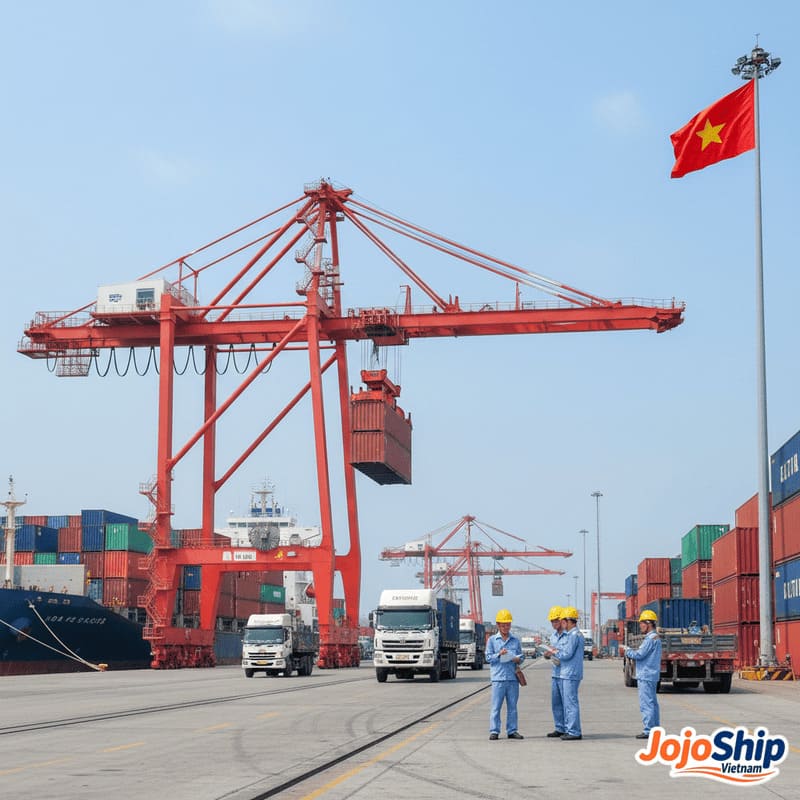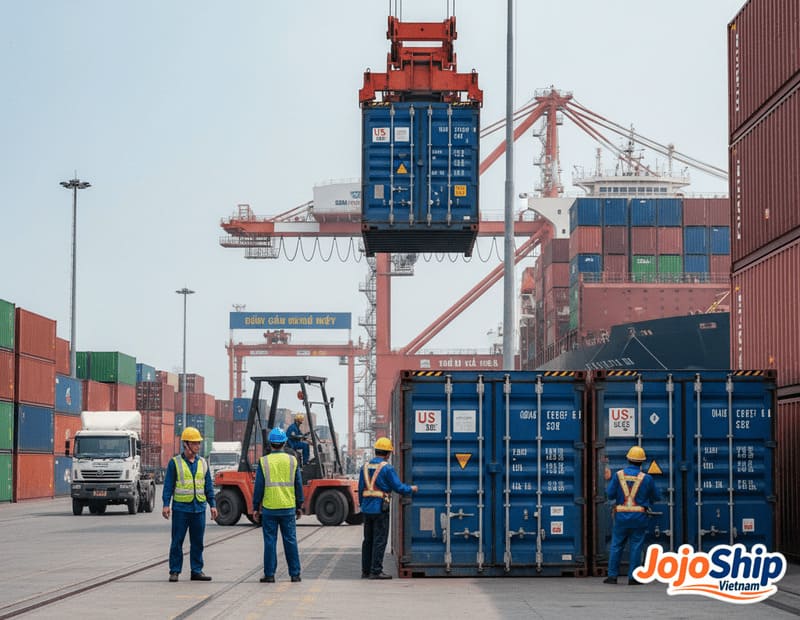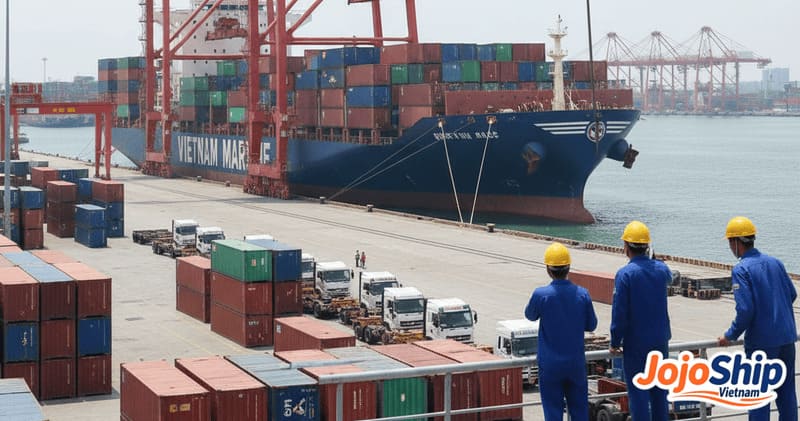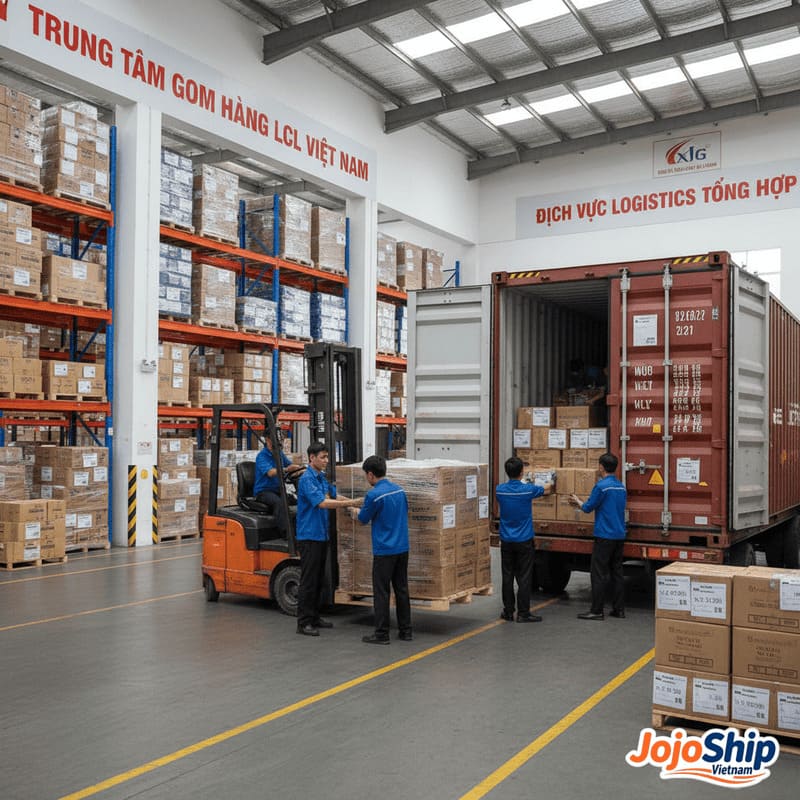Navigating Vietnam's complex shipping landscape can leave businesses drowning in confusion. With countless freight forwarders making similar claims, finding reliable container shipping services becomes a frustrating maze of unanswered emails, vague pricing, and inconsistent service quality.
Numerous companies offer ocean freight forwarding with container options from Vietnam, including international providers like Maersk, MSC, CMA CGM, and DHL Global Forwarding, alongside Vietnamese specialists such as Blue Ocean International, JojoShip Vietnam, FNM Vietnam, Unifreight Global, and Huong Nam Logistics, providing FCL and LCL services with various container types.

Vietnam's position as a major manufacturing hub has attracted many freight forwarders offering ocean shipping services. Let's examine the container options, pricing structures, and key considerations when selecting a partner for your Vietnam ocean freight needs.
How much does it cost to ship a container from Vietnam?
Determining container shipping costs from Vietnam1 feels like solving a puzzle with missing pieces. Quotes vary wildly between forwarders, hidden fees emerge unexpectedly, and pricing fluctuations make budgeting nearly impossible.
Shipping a 20-foot container from Vietnam to the USA costs $2,000-3,500, while 40-foot containers range from $2,500-4,500, depending on destination, season, and current market conditions. European routes average $1,800-3,200 for 20-foot and $2,300-4,200 for 40-foot containers, with additional charges for documentation, customs, and inland delivery.

Ocean freight costs from Vietnam have seen significant fluctuations in recent years due to global supply chain disruptions, capacity constraints, and changing trade patterns. Understanding the variables affecting these costs helps businesses budget accurately and avoid unexpected expenses.
Container Shipping Cost Components
Having managed hundreds of container shipments from Vietnam, I've seen firsthand how pricing structures work. Container shipping costs break down into several key components:
Base Ocean Freight Rates by Destination
| Destination | 20ft Container | 40ft Container | 40ft High Cube | Transit Time |
|---|---|---|---|---|
| US West Coast | $2,000-2,800 | $2,500-3,500 | $2,600-3,600 | 18-25 days |
| US East Coast | $2,500-3,500 | $3,000-4,500 | $3,100-4,600 | 35-42 days |
| Western Europe | $1,800-2,500 | $2,300-3,200 | $2,400-3,300 | 25-35 days |
| Middle East | $1,600-2,300 | $2,000-2,800 | $2,100-2,900 | 18-25 days |
| Australia | $1,400-2,000 | $1,800-2,500 | $1,900-2,600 | 15-20 days |
| Japan/Korea | $700-1,100 | $900-1,400 | $1,000-1,500 | 5-10 days |
These rates fluctuate seasonally and with market conditions. Just last month, I helped a furniture exporter secure rates 18% below market average by booking during a temporary dip in demand on Vietnam-US West Coast routes.
Additional Charges to Consider
Basic freight rates2 are only part of the total cost equation. Here are the typical additional charges3 you'll encounter:
-
Origin Charges:
- Terminal Handling Charge (THC): $150-250 per container
- Documentation fees: $50-100
- Export customs clearance: $100-200
- Seal fee: $10-20
- Container inspection: $30-80 (if required)
-
Destination Charges:
- Destination THC: $200-350
- Import customs clearance: $150-300
- Port/terminal fees: $200-400
- Chassis fee: $75-150 per day (US destinations)
-
Variable Surcharges:
- Bunker Adjustment Factor (BAF): 10-20% of base freight
- Peak Season Surcharge (PSS): $300-800 during high season
- Equipment Imbalance Surcharge: $100-300 in high-demand periods
- Currency Adjustment Factor: 5-8% depending on currency fluctuations
These additional costs can add 30-50% to the base ocean freight rate. I always advise clients to request "all-in" quotes to avoid surprises. Recently, one client was shocked to find an additional $1,200 in destination charges that weren't included in their initially quoted "low rate."
Special Container Types and Cost Premiums
Standard dry containers are just one option. Special cargo often requires specialized containers:
| Container Type | Premium Above Standard | Best For |
|---|---|---|
| Refrigerated (Reefer) | +150-200% | Temperature-sensitive goods |
| Open Top | +30-50% | Tall machinery, odd-shaped cargo |
| Flat Rack | +40-60% | Extra-wide cargo, vehicles |
| Tank Container | +200-300% | Liquid bulk cargo |
| Garment-On-Hanger | +40-60% | Hanging garments, fashion items |
One textile client saved significantly by switching from standard to garment-on-hanger containers, eliminating repacking costs at destination despite the higher container rate.
Factors Affecting Your Final Price
Several variables can significantly impact your shipping costs:
- Seasonality: Rates peak during August-October for holiday shipments and January-February before Lunar New Year
- Port of Origin: Ho Chi Minh City typically offers better rates than Hai Phong
- Routing: Direct services vs. transshipment routes (price difference of 10-15%)
- Volume Commitments: Regular shippers can negotiate 5-15% discounts
- Incoterms4: FOB vs. Ex-Works pricing structures affect total landed costs
By understanding these factors, you can make strategic decisions about when and how to ship. I've helped clients save up to 25% on their shipping costs by adjusting schedules to avoid peak seasons when their cargo wasn't time-sensitive.
What is the largest shipping company in Vietnam?
The Vietnamese shipping market feels overwhelming with dozens of providers claiming market leadership. Without reliable information, you risk partnering with companies that lack the capacity, reliability, or service network your business needs.
Vietnam National Shipping Lines (Vinalines) is the largest Vietnamese shipping company, recently rebranded as Vietnam Maritime Corporation (VIMC). Among international carriers serving Vietnam, Mediterranean Shipping Company (MSC), Maersk, and CMA CGM handle the highest container volumes through Vietnamese ports.

The shipping industry in Vietnam features a mix of state-owned enterprises, international shipping giants, and specialized freight forwarders. Understanding this landscape helps businesses identify the most suitable partners for their ocean freight needs.
Vietnam's Ocean Shipping Landscape
Having worked closely with Vietnam's shipping industry for years, I can provide insights into the key players and their relative positions in the market:
Major Vietnamese Shipping Companies
| Company | Ownership | Fleet Size | Special Strengths |
|---|---|---|---|
| Vietnam Maritime Corporation (VIMC/Vinalines) | State-owned | 60+ vessels | Extensive port operations, strong government connections |
| Hai An Transport & Stevedoring | Private | 10+ vessels | Container feeder services, regional strength |
| Gemadept Shipping | Private | 6+ vessels | Integrated logistics, warehouse network |
| Dong Do Marine | Private | 5+ vessels | Bulk cargo expertise, domestic routes |
| Vosco | Semi-private | 15+ vessels | Specialized in bulk and general cargo |
VIMC dominates the domestic market through its three core businesses: shipping, port operations, and maritime services. However, most Vietnamese companies focus on regional or domestic routes rather than long-haul international services.
I recently toured VIMC's operations at Hai Phong port and was impressed by their infrastructure investments, though many of my clients still prefer international carriers for transoceanic routes due to more frequent sailings and established global networks.
International Carriers with Strong Vietnam Presence
International shipping lines handle approximately 90% of Vietnam's container traffic to major global markets. The leading players include:
- Mediterranean Shipping Company (MSC): Largest carrier by Vietnam volume, weekly services to all major trade lanes
- Maersk Line: Extensive coverage, dedicated Vietnam-US services
- CMA CGM: Strong Intra-Asia and Europe services, owns significant terminal stakes
- COSCO Shipping: Dominant on Vietnam-China-US routes
- Evergreen Line: Substantial presence, especially for Taiwan and US routes
- ONE (Ocean Network Express): Growing rapidly in Vietnam-Japan-US trades
These carriers work with both direct customers and through freight forwarders. I've found that smaller businesses often get better rates and service by working through established forwarders who aggregate volume to negotiate with these major carriers.
Key Freight Forwarders Controlling Ocean Freight Volume
While not vessel operators themselves, certain freight forwarders control significant container volumes from Vietnam:
- DHL Global Forwarding: Market leader in Vietnam ocean freight forwarding
- DB Schenker Vietnam: Strong in industrial and automotive logistics
- Kuehne+Nagel Vietnam: Extensive global network, sophisticated IT systems
- Blue Ocean International: Leading Vietnamese-owned forwarder
- JojoShip Vietnam5: Specialized in US-bound container traffic
I've partnered with several of these forwarders and found that specialized regional players like JojoShip Vietnam5 often provide more attentive service for medium-sized shippers than the global giants.
Port Infrastructure and Market Impact
Vietnam's port system significantly influences the shipping market:
| Port | Location | Annual TEU Capacity | Major Carriers |
|---|---|---|---|
| Cai Mep-Thi Vai | South | 5+ million | Direct US/EU services |
| Cat Lai (HCMC) | South | 7+ million | All major lines |
| Hai Phong | North | 6+ million | All major lines, strong China routes |
| Da Nang | Central | 1+ million | Regional services, transshipment |
Cai Mep-Thi Vai's deep-water capacity has transformed Vietnam's shipping landscape, enabling direct services to US and European ports without transshipment. This has reduced transit times by 5-7 days for many routes compared to previous hub-and-spoke models through Singapore or Hong Kong.
What is the Vietnam cheapest way to ship a container?
Finding affordable container shipping from Vietnam feels like an endless search through misleading quotes and hidden costs. Many businesses pay premium rates unnecessarily because they don't understand the cost-saving options available.
The cheapest way to ship a container from Vietnam is through consolidated LCL for shipments under 15 CBM, specially negotiated FCL rates for full containers, transshipment routes rather than direct services, shipping from high-volume ports like Ho Chi Minh City, and booking during off-peak seasons (November-December, March-May).

Finding the most economical shipping method requires understanding various options and strategies. Based on my experience managing container shipments from Vietnam, here are proven approaches to minimize your shipping costs:
Cost-Optimized Container Shipping Strategies
After years of managing Vietnam exports, I've developed several reliable methods to reduce container shipping costs without sacrificing reliability:
Choosing the Right Container Option
For starters, selecting the appropriate container type and load method is crucial:
| Shipment Volume | Most Economical Option | Average Savings vs. Standard Approach |
|---|---|---|
| 1-15 CBM | LCL (consolidated)6 | 30-50% vs. small FCL |
| 15-25 CBM | 20ft container | 40-50% vs. partial 40ft |
| 25-55 CBM | 40ft standard container | 10-20% vs. multiple 20ft |
| 55-76 CBM | 40ft high cube | 15-25% vs. multiple containers |
| Heavy cargo (20+ tons) | 20ft container (weight optimized) | 25-35% vs. 40ft for heavy loads |
I recently helped a home goods importer save 42% by switching from two 20ft containers to one 40ft high cube for their 58 CBM shipment from Ho Chi Minh City7 to Los Angeles.
Consolidation Services for Smaller Shipments
For smaller volumes, consolidated options offer significant savings:
-
Traditional LCL: Sharing container space with other shippers
- Pro: Lowest cost for small shipments
- Con: Longer transit times (additional 5-7 days for consolidation/deconsolidation)
-
Buyer's Consolidation: Combining your multiple suppliers into one container
- Pro: Same rate as FCL with multi-supplier flexibility
- Con: Requires coordination and potential warehousing fees
-
Co-loading Programs: Partnering with complementary businesses to share containers
One furniture client reduced their shipping costs by 27% by participating in a co-loading program with three other businesses importing from the same Vietnamese industrial park.
Port Selection for Cost Optimization
Vietnam has multiple container ports with varying cost structures:
| Port | Average Cost Difference | Best For |
|---|---|---|
| Ho Chi Minh City7 (Cat Lai) | Baseline | General cargo, central/south production |
| Cai Mep-Thi Vai9 | +5-10% higher | Direct services, faster transit times |
| Hai Phong | +10-15% higher | Northern production locations |
| Da Nang | +15-20% higher | Central Vietnam production, smaller volumes |
Many businesses default to shipping from the port nearest their factory, but this isn't always most economical. I've worked with several clients who saved 8-12% by trucking their goods from northern factories to southern ports despite the additional inland transportation costs.
Timing Strategies for Lower Rates
Shipping costs follow predictable seasonal patterns:
| Period | Rate Level | Potential Savings |
|---|---|---|
| January-February (pre-Lunar New Year) | Peak | Limited - avoid if possible |
| March-May | Low season | 15-25% below average |
| June-July | Moderate | 5-10% below average |
| August-October | Peak season | Limited - avoid if possible |
| November-December | Moderate to low | 10-20% below average |
For non-urgent cargo, adjusting shipping schedules to avoid peak periods can yield substantial savings. One client who manufactures seasonal products shifted their production schedule to ship during March-April instead of August-September, saving approximately 22% on annual freight costs.
Negotiation and Volume Strategies
Working with forwarders strategically can unlock additional savings:
- Annual Volume Commitments: Guaranteeing container numbers for 10-15% discounts
- Multi-Origin Consolidation: Leveraging combined volumes from China and Vietnam
- Backhaul Utilization: Finding carriers with empty containers returning to your destination
- NVO (Neutral) vs. Carrier Rates: Comparing options between forwarders and direct carrier sales
When I help clients negotiate their shipping contracts, we typically focus on annual volume commitments10 rather than spot rates. One electronics manufacturer secured rates 18% below market by committing to 120 containers per year on Vietnam-US routes, with flexibility to adjust monthly allocations based on their production schedule.
Total Cost Approach
The cheapest option on paper isn't always the most economical overall:
- Transit Time Value: Calculate inventory carrying costs and market opportunity costs
- Reliability Factor: Some low-cost services have higher rates of delays and rollovers
- Documentation Efficiency: Faster customs clearance can offset slightly higher freight costs
- Insurance Requirements: Some routes or carriers require additional coverage
I always recommend a total landed cost analysis11 rather than focusing solely on the freight rate. For instance, one client initially chose a "cheaper" service that saved $300 per container but resulted in consistent delays that cost them approximately $1,200 per container in expedited delivery fees and lost sales opportunities.
With JojoShip Vietnam, we take this total cost approach, helping clients understand all variables rather than simply providing the lowest initial quote. This transparency has helped our customers achieve sustainable cost savings rather than one-time discounts that often lead to service issues.
Conclusion
Numerous reputable companies offer ocean freight forwarding with container options from Vietnam, including international shipping lines, global logistics providers, and specialized Vietnamese forwarders. By understanding shipping costs, selecting the right container options, choosing optimal ports, timing shipments strategically, and negotiating based on volume, businesses can significantly reduce their shipping expenses while maintaining reliable supply chains from Vietnam to global markets.
-
Explore this link to understand the various factors that influence shipping costs, helping you budget more effectively. ↩
-
This resource explains the dynamics of freight rates, helping you anticipate changes in shipping costs. ↩
-
Understanding additional charges is crucial for accurate budgeting; this link offers a comprehensive breakdown. ↩
-
Understanding Incoterms is vital for calculating total landed costs; this link provides essential insights. ↩
-
Learn how JojoShip Vietnam offers specialized services that cater to medium-sized shippers. ↩ ↩
-
Explore the advantages of LCL shipping for small businesses looking to save. ↩
-
Find out why Ho Chi Minh City is a preferred port for cost-effective shipping. ↩ ↩
-
Learn about FCL rates and negotiation strategies to save on shipping costs. ↩
-
Explore the advantages of using Cai Mep-Thi Vai for faster transit times. ↩
-
Understand how committing to annual volumes can unlock significant shipping discounts. ↩
-
Learn about total landed cost analysis to make informed shipping decisions. ↩




